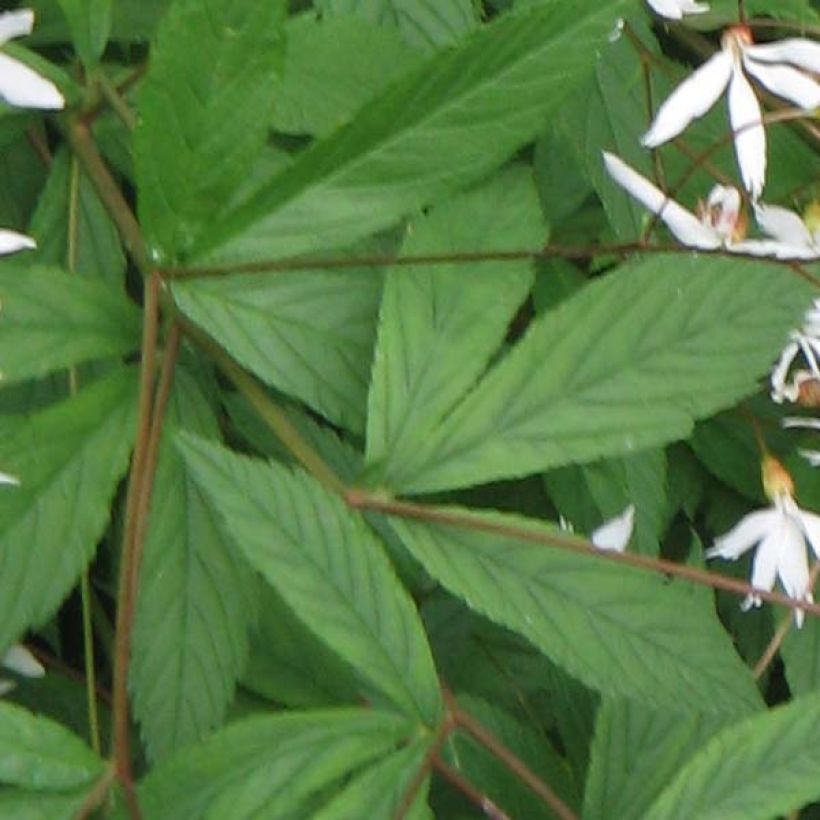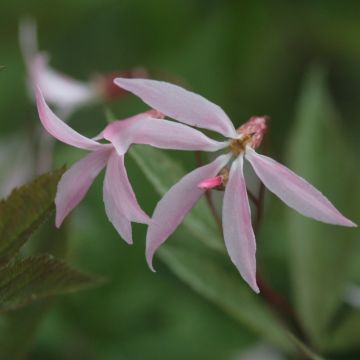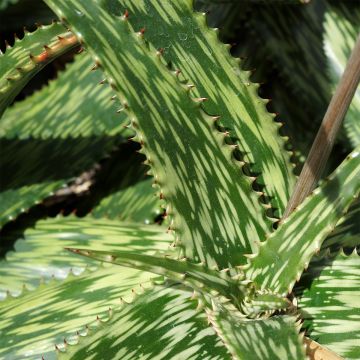

Gillenia trifoliata


Gillenia trifoliata


Gillenia trifoliata
Gillenia trifoliata
Gillenia trifoliata
Bowman's root, Indian physic, False ipecac, Indian hippo, Western dropwort
Planted a year ago. Slow establishment, but the plant shows great promise! Lovely flowers and beautiful autumn foliage colours.
NL, 10/10/2024
This item cannot be shipped to the selected country
Delivery charge from €5.90
More information
Schedule delivery date,
and select date in basket
This plant carries a 12 months recovery warranty
More information
We guarantee the quality of our plants for a full growing cycle, and will replace at our expense any plant that fails to recover under normal climatic and planting conditions.
From €5.90 for pickup delivery and €6.90 for home delivery
Express home delivery from €8.90.

Does this plant fit my garden?
Set up your Plantfit profile →
Description
Gillenia trifoliata, also known as three-leaved gillenia or three-leaved spirea, is a perennial plant of the forest floor that is infinitely graceful. It has an elegant stature. From early summer, it is adorned with tiny but countless white star-shaped flowers with red calyxes, which persist on their purple stems for a long time. Before bidding farewell in autumn, its lovely foliage, which is divided into 3 leaflets, takes on fiery hues. Delicate and ethereal, it beautifies shaded areas, even in the roots of trees. In the garden, it only fears limestone soils and excessively dry conditions. The three-leaved spirea pairs well with Solomon's seal, astilbes, barrenworts, and all plants that thrive in ericaceous soil, in semi-shade.
Gillenia trifoliata (synonym Porteranthus trifoliatus) is a perennial herbaceous plant with a rhizomatous rootstock. It belongs to the Rosaceae family, and is a cousin of spireas, brambles, and roses. It is native to mountainous areas of North America, where it often grows on the edge of forests, in a thick layer of humus. It takes a little while to establish, but within 4 to 5 years it forms a rounded mass that reaches an average height of 1.1m (4ft) and a width of 70cm (28in). The plant spreads laterally through its rhizomes. In spring, woody, slender, and branched yellow to purple stems emerge from the ground. They bear deciduous leaves divided into 3 ovate, pointed, and finely dentate leaflets. The foliage is a shade of matte dark green, taking on sumptuous orange hues in autumn before falling.
The flowering occurs in May-June and can continue until August depending on the climate. The pure white star-shaped flowers are carried by thin reddish stems, well above the foliage. Measuring 2 to 3cm (1in) long, they consist of 5 slender petals that are very pale-pink when they bloom, quickly turning white. The reddish calyxes at the base of the flowers persist on the plant after the petals have fallen. This nectar-bearing flowering attracts numerous pollinating insects as well as certain birds. Occasionally, decorative mahogany-coloured fruits form and last late into the season. The stems die in winter and should be pruned in spring when vegetation resumes.
With its graceful appearance, Gillenia trifoliata stands out in flower beds, away from the scorching sun. It is best planted on the edge of a grove or near a hedge, where it will tolerate root competition and appreciate soil covered with decomposing leaf litter. It pairs well with all sorts of woodland plants, such as bearded irises, Solomon's seal, lily-of-the-valley, fairy bells, Phaeum geraniums, Salvia sylvestris, Brunnera, and many others. Its ethereal flowering complements those of rhododendrons, hydrangeas, and azaleas in acidic soil. Its combination with purple heucheras is fantastic.
Report an error about the product description
Gillenia trifoliata in pictures




Flowering
Foliage
Plant habit
Botanical data
Gillenia
trifoliata
Rosaceae
Bowman's root, Indian physic, False ipecac, Indian hippo, Western dropwort
North America
Other Gillenia - Bowman's root
Planting and care
To successfully grow Gillenia trifoliata, plant the stump in limestone-free soil that is rich in humus, and neither too dry nor too wet. Place in a position that is not too sunny but not too shaded either. Its mountainous origins allow it to thrive in gardens at medium altitudes. Gastropods are fond of young spring shoots. Prune in late winter or early spring, just as vegetation starts to regrow.
Planting period
Intended location
Care
-
, onOrder confirmed
Reply from on Promesse de fleurs
Summer flowering perennials
Haven't found what you were looking for?
Hardiness is the lowest winter temperature a plant can endure without suffering serious damage or even dying. However, hardiness is affected by location (a sheltered area, such as a patio), protection (winter cover) and soil type (hardiness is improved by well-drained soil).

Photo Sharing Terms & Conditions
In order to encourage gardeners to interact and share their experiences, Promesse de fleurs offers various media enabling content to be uploaded onto its Site - in particular via the ‘Photo sharing’ module.
The User agrees to refrain from:
- Posting any content that is illegal, prejudicial, insulting, racist, inciteful to hatred, revisionist, contrary to public decency, that infringes on privacy or on the privacy rights of third parties, in particular the publicity rights of persons and goods, intellectual property rights, or the right to privacy.
- Submitting content on behalf of a third party;
- Impersonate the identity of a third party and/or publish any personal information about a third party;
In general, the User undertakes to refrain from any unethical behaviour.
All Content (in particular text, comments, files, images, photos, videos, creative works, etc.), which may be subject to property or intellectual property rights, image or other private rights, shall remain the property of the User, subject to the limited rights granted by the terms of the licence granted by Promesse de fleurs as stated below. Users are at liberty to publish or not to publish such Content on the Site, notably via the ‘Photo Sharing’ facility, and accept that this Content shall be made public and freely accessible, notably on the Internet.
Users further acknowledge, undertake to have ,and guarantee that they hold all necessary rights and permissions to publish such material on the Site, in particular with regard to the legislation in force pertaining to any privacy, property, intellectual property, image, or contractual rights, or rights of any other nature. By publishing such Content on the Site, Users acknowledge accepting full liability as publishers of the Content within the meaning of the law, and grant Promesse de fleurs, free of charge, an inclusive, worldwide licence for the said Content for the entire duration of its publication, including all reproduction, representation, up/downloading, displaying, performing, transmission, and storage rights.
Users also grant permission for their name to be linked to the Content and accept that this link may not always be made available.
By engaging in posting material, Users consent to their Content becoming automatically accessible on the Internet, in particular on other sites and/or blogs and/or web pages of the Promesse de fleurs site, including in particular social pages and the Promesse de fleurs catalogue.
Users may secure the removal of entrusted content free of charge by issuing a simple request via our contact form.
The flowering period indicated on our website applies to countries and regions located in USDA zone 8 (France, the United Kingdom, Ireland, the Netherlands, etc.)
It will vary according to where you live:
- In zones 9 to 10 (Italy, Spain, Greece, etc.), flowering will occur about 2 to 4 weeks earlier.
- In zones 6 to 7 (Germany, Poland, Slovenia, and lower mountainous regions), flowering will be delayed by 2 to 3 weeks.
- In zone 5 (Central Europe, Scandinavia), blooming will be delayed by 3 to 5 weeks.
In temperate climates, pruning of spring-flowering shrubs (forsythia, spireas, etc.) should be done just after flowering.
Pruning of summer-flowering shrubs (Indian Lilac, Perovskia, etc.) can be done in winter or spring.
In cold regions as well as with frost-sensitive plants, avoid pruning too early when severe frosts may still occur.
The planting period indicated on our website applies to countries and regions located in USDA zone 8 (France, United Kingdom, Ireland, Netherlands).
It will vary according to where you live:
- In Mediterranean zones (Marseille, Madrid, Milan, etc.), autumn and winter are the best planting periods.
- In continental zones (Strasbourg, Munich, Vienna, etc.), delay planting by 2 to 3 weeks in spring and bring it forward by 2 to 4 weeks in autumn.
- In mountainous regions (the Alps, Pyrenees, Carpathians, etc.), it is best to plant in late spring (May-June) or late summer (August-September).
The harvesting period indicated on our website applies to countries and regions in USDA zone 8 (France, England, Ireland, the Netherlands).
In colder areas (Scandinavia, Poland, Austria...) fruit and vegetable harvests are likely to be delayed by 3-4 weeks.
In warmer areas (Italy, Spain, Greece, etc.), harvesting will probably take place earlier, depending on weather conditions.
The sowing periods indicated on our website apply to countries and regions within USDA Zone 8 (France, UK, Ireland, Netherlands).
In colder areas (Scandinavia, Poland, Austria...), delay any outdoor sowing by 3-4 weeks, or sow under glass.
In warmer climes (Italy, Spain, Greece, etc.), bring outdoor sowing forward by a few weeks.














































